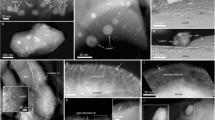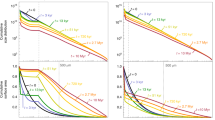Abstract
‘Space weathering’ is the term applied to the darkening and reddening of planetary surface materials with time, along with the changes to the depths of absorption bands in their optical spectra. It has been invoked to explain the mismatched spectra of lunar rocks and regolith, and between those of asteroids and meteorites1,2,3,4,5,6. The formation of nanophase iron particles on regolith grains as a result of micrometeorite impacts or irradiation by the solar wind has been proposed as the main cause of the change in the optical properties7,8. But laboratory simulations9,10,11,12,13,14 have not revealed the presence of these particles, although nano-second-pulse laser irradiation did reproduce the optical changes12. Here we report observations by transmission electron microscopy of olivine samples subjected to pulse laser irradiation. We find within the amorphous vapour-deposited rims of olivine grains nanophase iron particles similar to those observed in the rims of space-weathered lunar regolith grains15,16. Reduction by hydrogen atoms implanted by the solar wind is therefore not necessary to form the particles. Moreover, the results support the idea that ordinary chondrites came from S-type asteroids5, and thereby provides some constraints on the surface exposure ages of those asteroids.
This is a preview of subscription content, access via your institution
Access options
Subscribe to this journal
Receive 51 print issues and online access
$199.00 per year
only $3.90 per issue
Buy this article
- Purchase on Springer Link
- Instant access to full article PDF
Prices may be subject to local taxes which are calculated during checkout



Similar content being viewed by others
References
Adams, J. B. & McCord, T. B. Alteration of lunar optical properties: age and composition effects. Science 171, 567–571 (1971).
Chapman, C. R. & Salisbury, J. W. Comparison of meteorite and asteroid spectral reflectivities. Icarus 19, 507–522 (1973).
Gaffey, M. J. & McCord, T. B. Asteroid surface materials: Mineralogical characterizations from reflectance spectra. Space Sci. Rev. 21, 555–628 (1978).
Wetherill, G. W. & Chapman, C. R. in Meteorites and the Early Solar System (eds Kerridge, J. F. & Matthews, M. S.) 35–67 (Univ. Arizona Press, Tucson, 1988).
Chapman, C. R. S-type asteroids, ordinary chondrites, and space weathering: The evidence from Galileo's fly-bys of Gaspra and Ida. Meteor. Planet. Sci. 31, 699–725 (1996).
Pieters, C. M. et al. Space weathering on airless bodies: Resolving a mystery with lunar samples. Meteor. Planet. Sci. 35, 1101–1107 (2000).
Hapke, B., Cassidy, W. & Wells, E. Effects of vapor-phase deposition processes on the optical, chemical and magnetic properties of the lunar regolith. Moon 13, 339–353 (1975).
Hapke, B. Space weathering in the asteroid belt. Lunar Planet. Sci. 31, 1087 (2000).
Clark, B. E., Fanale, F. P. & Salisbury, J. W. Meteorite-asteroid spectral comparison: The effects of comminution, melting, and recrystallization. Icarus 97, 288–297 (1992).
Moroz, L. V., Fisenko, A. V., Semjonova, L. F., Pieters, C. M. & Korotaeva, N. N. Optical effects of regolith processes on S-asteroids as simulated by laser shots on ordinary chondrite and other mafic materials. Icarus 122, 366–382 (1996).
Yamada, M. et al. in Antarctic Meteorites Vol. 23, 173–176 (National Inst. Polar Res., Tokyo, 1998).
Yamada, M. et al. Simulation of space weathering of planet-forming materials: Nanosecond pulse laser irradiation and proton implantation on olivine and pyroxene samples. Earth Planets Space 51, 1255–1265 (1999).
Hiroi, T. & Sasaki, S. Importance of olivine in S-asteroid space weathering. Lunar Planet. Sci. 30, 1444 (1999).
Hiroi, T. & Sasaki, S. First successful simulation of the asteroid space weathering using reflectance spectra of pulse laser irradiated olivine and pyroxene samples—Possible compositional dependency of S-asteroid space weathering. Meteor. Planet. Sci. (submitted).
Keller, L. P. & McKay, D. S. Discovery of vapor deposits in the lunar regolith. Science 261, 1305–1307 (1993).
Keller, L. P. & McKay, D. S. The nature and origin of rims on lunar soil grains. Geochim. Cosmochim. Acta. 61, 2331–2341 (1997).
Gaffey, M. J. et al. Mineralogical variations within the S-type asteroid class. Icarus 106, 573–602 (1993).
Clark, B. E. & Hiroi, T. S-type asteroid spectral continua: Redness and Fe, Ni metal. Bull. Am. Astron. Soc. 26, 1172 (1994).
Clark, B. E. Spectral mixing models of S-type asteroids. J. Geophys. Res. 100, 14443–14456 (1995).
Allen, C. C., Morris, R. V., Lauer, H. V. Jr. & McKay, D. S. Microscopic iron metal on glass and minerals—A tool for studying regolith maturity. Icarus 104, 291–300 (1993).
Binzel, R. P., Bus, S. J., Burbine, T. H. & Sunshine, J. M. Spectral properties of near-Earth asteroids: Evidence for sources of ordinary chondrite meteorites. Science 273, 946–948 (1996).
Trombka, J. I. et al. The elemental composition of asteroid 433 Eros: Results of the NEAR-Shoemaker X-ray spectrometer. Science 289, 2101–2105 (2000).
Grün, E. et al. in Origin and Evolution of Interplanetary Dust (eds Levasseur-Regourd, A. C. & Hasegawa, H.) 21–32 (Kluwer, Dordrecht, 1991).
Acknowledgements
We thank M. Yamada for discussions and help in laser irradiation experiments, J. Owada and H. Akiyama for technical support during reflectance measurements, and H. Nagahara and K. Tomeoka for discussions and support. We thank T. Kogure for preliminary measurements by TEM and K. Akamatsu for technical advice during our TEM measurements. We also thank L. Keller for discussions on TEM analysis. We thank C. R. Chapman and B. E. Clark for their valuable comments. This work was partially supported by a Grant-in-Aid for Science Research from the Ministry of Education, Culture, Sports, Science and Technology, Japan and by a grant from the Inamori Foundation.
Author information
Authors and Affiliations
Corresponding author
Rights and permissions
About this article
Cite this article
Sasaki, S., Nakamura, K., Hamabe, Y. et al. Production of iron nanoparticles by laser irradiation in a simulation of lunar-like space weathering. Nature 410, 555–557 (2001). https://doi.org/10.1038/35069013
Received:
Accepted:
Issue Date:
DOI: https://doi.org/10.1038/35069013
This article is cited by
-
Unusual Ti minerals on the Moon produced by space weathering
Nature Astronomy (2024)
-
Surface Compositions of Trojan Asteroids
Space Science Reviews (2024)
-
A plasma irradiation system optimized for space weathering of solar system bodies
Earth, Planets and Space (2023)
-
Influx of nitrogen-rich material from the outer Solar System indicated by iron nitride in Ryugu samples
Nature Astronomy (2023)
-
Space weathering signatures in sulfide and silicate minerals from asteroid Itokawa
Earth, Planets and Space (2022)
Comments
By submitting a comment you agree to abide by our Terms and Community Guidelines. If you find something abusive or that does not comply with our terms or guidelines please flag it as inappropriate.



